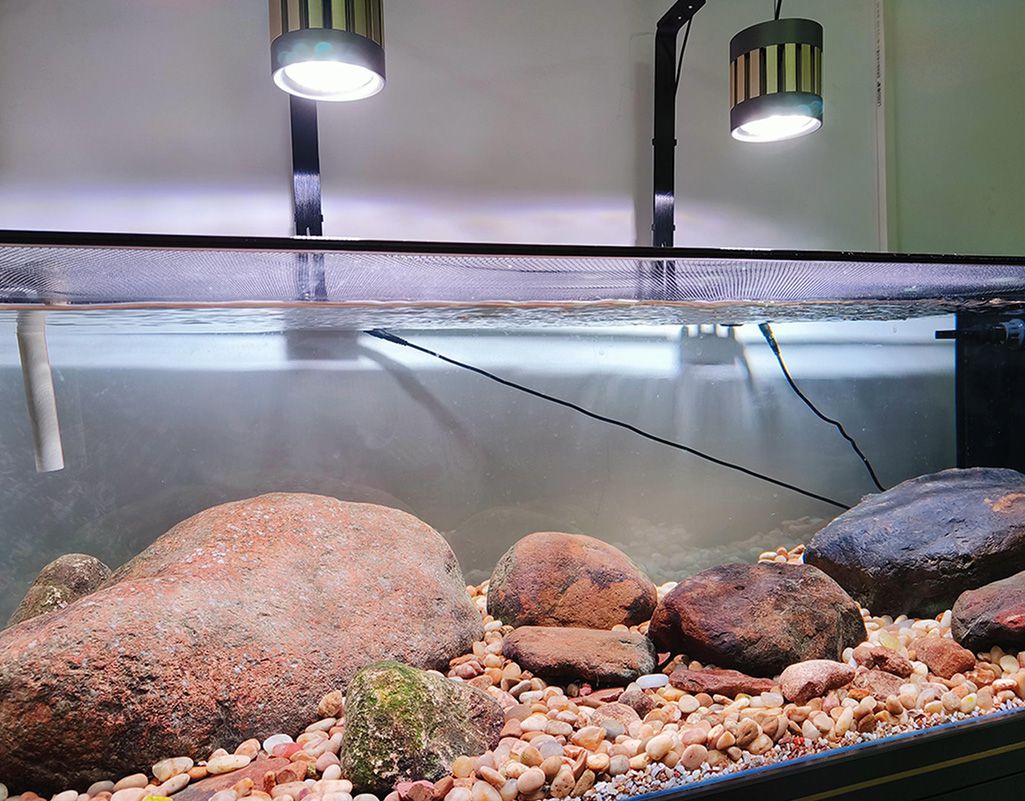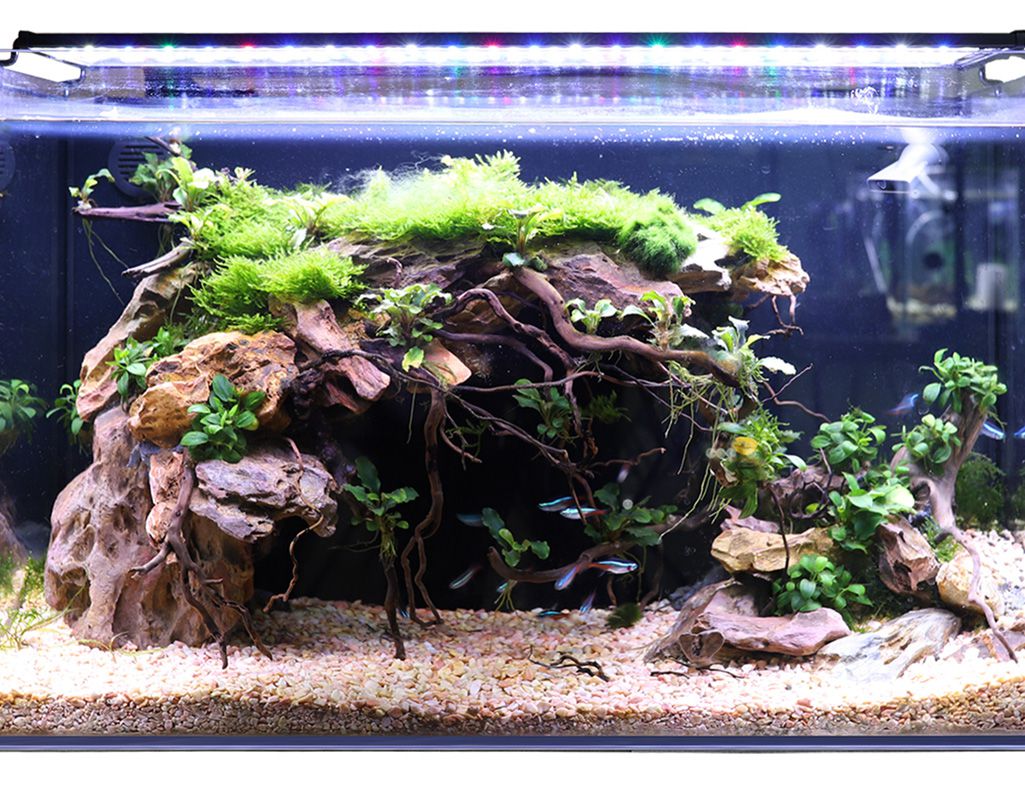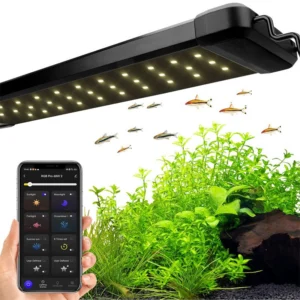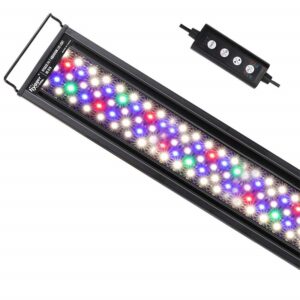-Will a fish tank light heat the water?
Aquarium light is necessary for aquatic plants and fish growth. And it improves the ornamental value. LED, incandescent, fluorescent, and other lights are available for aquariums. But you should choose the best one according to your tank needs. In today’s article, let’s learn more about aquarium lights.
Content Table
Aquarium Lighting LEDs
Aquarium light is a lamp to help plants and fish grow healthily, which mimics the sunlight. Also, some lights glow in different colors, which have diverse functions. The great light colors are red, blue, and white. The ideal light colors for freshwater tanks are a combination of red and blue light. But for saltwater tanks, the combination of blue and white light is a better choice. Next, we will share functions for white, red, and blue lights.
- White light: It promotes the plants’ photosynthesis, and enhances the colors of plants and fish.
- Red light: It makes fish’s colors more vibrant. And it is ideal for discus fish, blood parrots, red goldfish, and other ornamental fish.
- Blue light: Blue light is helpful to calcium absorption. Also, it fits shrimp, duckbill fish, corals, and others. With blue light, their colors will be more brilliant.
Additionally, there are various lights for aquariums, such as LED, incandescent, fluorescent and halide lights. In this part, let’s get into a deeper learning of these aquarium lights.
LED light
The LED light should be the best alternative. Because it is the most efficient one among aquarium lights. And it gives off less heat, thus, it will not be damaging to your fish. Also, an ultraviolet LED light helps to sterilize, which reduces the risk of fish disease. Besides that, many LED lights have customizable settings for lighting color and intensity. And it makes LED lights suitable for various fish tanks, and planted tanks. For a planted tank, a full-spectrum LED light is a perfect choice. With 7 adjustable colors, the light also has thickened aluminum, which can increase heat dissipation efficiency and promote the plant’s growth.
Pros:
- Lower heat emission
- Lower energy consumption
- Make the electric bills lower
- Improve ornamental value
- Longer lifespan
- Dimming or other custom options
Cons:
- More initial costly
Incandescent light
Commonly, incandescent light is an alternative for your fish tank. The brightness can be adjusted with rheostats. But you may need to replace the light bulbs frequently. Also, it will give out excessive heat in the aquarium water, which may be damaging to plants, fish, and other creatures in your tank.
Pros:
- Low initial cost
- High light output
Cons:
- Lower light penetration under 12 inches in your tank
- Low luminous efficiency
- Heat aquarium water
- Light bulbs replacement
- Shorter lifespan
Fluorescent light
Featuring white, blue, or red light, fluorescent light is one common aquarium light. However, its function is limited, which may be only used for lighting sometimes. But it is beneficial for photosynthesis and oxygen release in planted tanks.
Pros:
- Affordable
- Good for plant growth
Cons:
- Narrow applicability
- Excessive heat emission
Halide light
With strong light penetration and great color rendering, halide light emits light similar to sunlight, which makes sense in sterilizing. Also, halide light can replicate the lighting conditions for fish from tropical regions. However, it generates excessive heat.
Pros:
- High luminous efficiency
- Helpful to sterilize
Cons:
- Narrow applicability
- Give off heat

Do all tanks need LED lights?
In tanks, aquarium lights are mainly used to bring out the colors of fish and plants or improve the ornamental value. Actually, whether should you add an LED light depends on your tank types, like a neon tetras tank, a clownfish tank, or a planted tank. Factors, including aquarium environment, water quality, lighting conditions, as well as fish and plant density or others, would determine the types of lights you need.
For instance, you can use a halide light in planted tanks instead of an LED light. On the contrary, however, it is best to use an LED light in cichlids or some other saltwater aquariums. Because they require blue light. Exactly, the aquarium bluetooth LED lights are a great option. Featuring high-quality 5054 RGB LED beads, the bluetooth LED light possesses a color rendering index of up to 95. And the color temperature is 3000-6700K. Also, free dimming of RGB three primary colors enables you to choose 300+ colors. Furthermore, brightness and color temperature can be adjusted after you connect the light via Bluetooth. Sounds not bad, right?
Will a fish tank light heat the water?
Aquarium light is essential for your fish tank. But will the tank light heat the water? It depends on the light types. Generally, LED light will not heat the water, while incandescent and fluorescent lights will. In this segment, let’s learn more about whether the lights heat the aquarium water or not.
LED light
Generally, LED light heats the aquarium water. But it emits less heat. So it does not matter. Nonetheless, do not keep it open for a long time, which is bad for your tank. Usually, it is best to keep the light on for about 8–12 hours. About setting the proper lighting intensity, just take the reference in the article for your tank.

Incandescent light
With a wire filament, incandescent light will generate light as it heats up. However, it is less efficient than other lights. Only part of electric energy is converted into light, while residual energy will be converted into heat. The more light, the higher the heat.
Fluorescent light
The same as incandescent light, there is also energy that is converted into heat. But fluorescent light is more efficient than incandescent light and produces less heat.
By the way, here are some tips about reducing heat in aquariums:
- Install a timer to control the lighting hours
- Decrease the room temperature
- Improve aeration
- Add a fan above your aquarium
- Avoid direct sunlight
Sum up
In summary, LED lights are the most efficient ones for aquariums. Also, they are the most economical in the long term. For more additional information about aquarium lights, you can go to the series topic: Aquarium Lighting Basics Part One.
That is all for today. Wish you the best in your aquatics. Finally, thanks for your reading.



Leave a comment